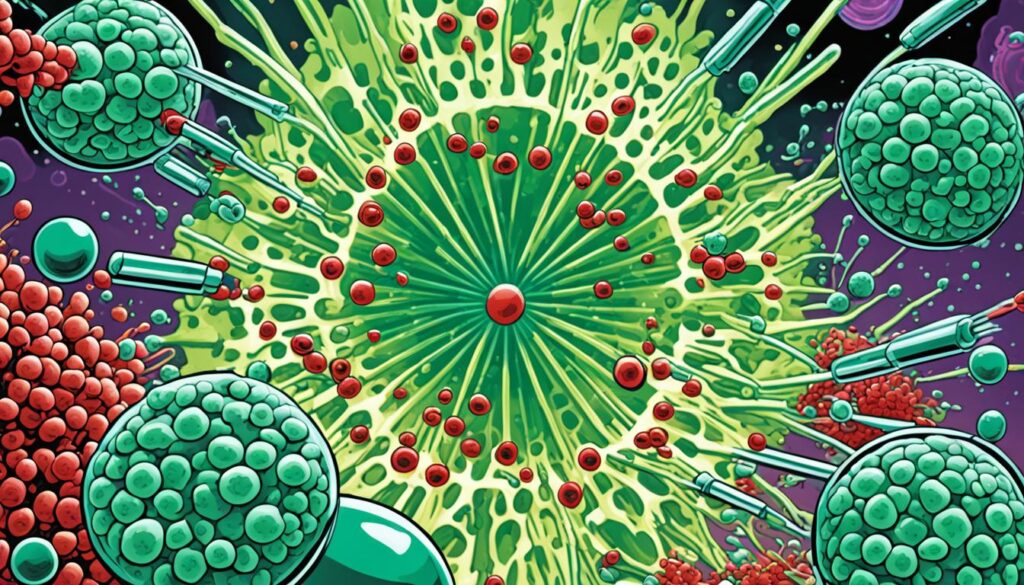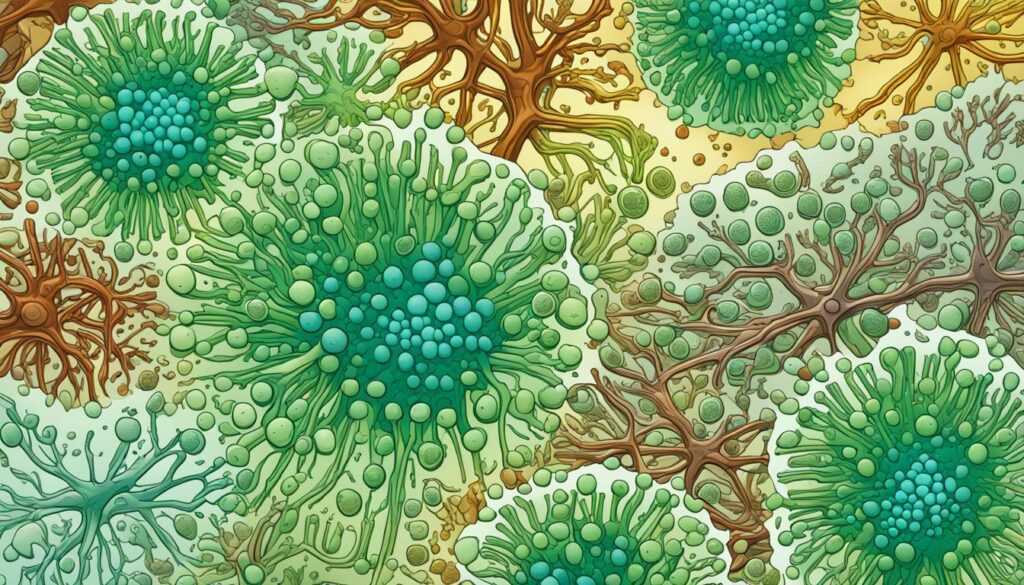How do tiny bacteria, which we can’t see, talk to each other and work together? This question leads us into a world where microorganisms use quorum sensing to interact. This system allows them to share important updates about their numbers using signaling molecules called autoinducers. This way, they manage their resources better and switch on defense mechanisms when necessary.
By exploring how bacteria communicate, we learn a lot about their world. We also see how this knowledge can help humans. For instance, it could lead to new ways to fight antibiotic resistance. This makes studying quorum sensing very important123.
Key Takeaways
- Quorum sensing enables bacteria to communicate and coordinate behavior based on population density.
- Autoinducers are crucial for this cell-to-cell communication.
- Microbial interactions are vital for understanding bacterial survival strategies.
- The implications of quorum sensing extend to human health, particularly in the context of antibiotic resistance.
- Research continues to uncover novel therapeutic approaches targeting quorum sensing pathways.
Introduction to Bacterial Communication
Bacteria talk to each other in fascinating ways that affect the world around us. This talk influences everything from nature to our health. By studying how they communicate, we learn more about their collective behavior and their impact.
The Importance of Microbial Interactions
Microbial interactions keep nature in balance. They help cycle nutrients and manage how many bacteria are in a place. For instance, when bacteria work together, they are more likely to survive changes in their environment. This teamwork is crucial in nature.
Also, good bacteria in our bodies help us stay healthy. They fight off harmful germs and help our immune systems. This shows how teamwork among bacteria is good for us too.
Understanding Bacterial Complexity
Bacteria do more than just cause diseases. Their complex behaviors within communities play key roles in ecosystems. By sending chemical signals to each other, they can do tasks like forming protective layers and sharing resources.
This coordination is vital for their group success. As we learn more, the importance of understanding these communications grows. It’s key for advances in technology and enhancing health. This is why diving deep into how bacteria communicate is so important45.
What is Quorum Sensing?
Quorum sensing is how bacteria talk to each other based on how many of them are around. They use special signals called autoinducers. These signals are made by bacteria and released outside. As more bacteria gather, the stronger these signals become. This leads to all bacteria working together, switching from acting alone to acting as a group.
Definition and Mechanism
Bacteria count themselves using autoinducers. In gram-negative bacteria, these signals come from a substance called S-adenosylmethionine (SAM). These signals then bind to receptors. This sets off a chain reaction leading to changes in what genes do. This includes making things that help them survive67. A feedback loop happens next, where more signals mean more production, making the community act together even more7.
Types of Autoinducers
There are different signals for different bacteria. Gram-positive bacteria use peptides, and gram-negative ones use something called N-acyl homoserine lactones (AHLs)6. These signals help bacteria talk not only to their kind but also to others. This affects whether they compete or cooperate. Knowing how this works helps scientists find new ways to stop bad bacteria without killing them86.

Mechanisms of Quorum Sensing
Getting why bacteria react to how many of them there are is key. They release and sense chemicals called autoinducers. This helps them track their numbers and control things like layer formation, danger levels, becoming skilled, and forming spores9. By sending out and picking up signals, bacteria can work together better. This helps them survive in changing places9.
How Bacteria React to Population Density
As more bacteria gather, they start acting as one. When there are enough of them, they all respond together because of the chemicals they’ve released9. Things like how well stuff moves through the area, acidity, oxygen, and anti-bug drugs can change how these chemicals are spread. This affects how bacteria form groups and deal with what’s around them10.
Signal Transmission in Gram-Positive vs. Gram-Negative Bacteria
How bacteria send signals can vary, especially between Gram-positive and Gram-negative types. In Gram-negative ones, specific molecules called acyl-homoserine lactones let them talk and act as a group10. On the flip side, Gram-positive bacteria use tiny protein pieces for the same goal10. Knowing the differences in these signal ways is crucial. Especially for fighting bacteria in places like factories where keeping things clean without buildup is important10.

Quorum Sensing in Pathogenic Bacteria
Quorum sensing is a key behavior in harmful bacteria like Staphylococcus aureus and Vibrio cholerae. These bacteria use complex signals to boost their strength and survive inside hosts.
Case Study: Staphylococcus aureus
The germ Staphylococcus aureus uses a quorum-sensing system called Agr. This system controls important factors for its harmfulness. It’s a major reason for infections caught in hospitals. For Staphylococcus aureus, quorum sensing is essential11. It helps coordinate its actions in different environments. This makes its infection strategies more effective.
Case Study: Vibrio cholerae
Vibrio cholerae causes cholera and uses quorum sensing too. It controls biofilm production and the making of cholera toxin. This helps it infect the host better12. The harmful factors of Vibrio cholerae are closely connected to its communication. This is very important for controlling and managing infections.

| Pathogen | Quorum Sensing Mechanism | Virulence Factors | Impact on Infection |
|---|---|---|---|
| Staphylococcus aureus | Agr system | Exotoxins, Adhesins | Hospital-acquired infections |
| Vibrio cholerae | Biofilm formation | Cholera toxin | Gastrointestinal infections |
Quorum sensing is crucial for the dangerous power of these bacteria. Understanding this can help invent new treatments. These treatments would block their signals, lowering infection risks13.
Implications for Disease Control
Knowing how quorum sensing works in bacteria is key for disease control. This is especially true for fighting antibiotic resistance and bacterial infections. Quorum sensing helps bacteria talk to each other. It affects a big part of their genes (about 4% to 10%) and proteins (over 20%)14.
Scientists want to block this communication. They believe it will make antibiotics work better against harmful bacteria.
Quorum Sensing and Antibiotic Resistance
Studies show that messing with quorum sensing can stop bacteria from being harmful. It stops them from forming biofilms and becoming resistant to antibiotics15. A lot of work is being done on quorum sensing blockers. They could make harmful bacteria weaker by stopping their signals15.
Some bacteria made in labs without quorum sensing are less dangerous in animal tests. This shows how important quorum sensing is for harmful bacteria like Pseudomonas aeruginosa14.
Novel Therapeutics Targeting Quorum Sensing
The battle against antibiotic resistance is getting tougher. New treatments that target quorum sensing are being developed. These include quorum sensing blockers like polyphenols and eugenol. They change how bacteria communicate15.
This approach aims to mess up the bacteria’s teamwork. It tries to stop them from creating biofilms and resisting drugs15.

The Role of Quorum Sensing in Biofilm Formation
Quorum sensing is key to biofilm creation, communities of tough bacteria. These biofilms form strong defenses, showing off how bacteria protect themselves. Thanks to quorum sensing, bacteria can build these shields, making them tough to beat.
Biofilms as a Defense Mechanism
Biofilms give bacteria an edge, especially when times are hard. Over 55 species can make a special signal, AI-2, that helps them work together for survival16. Also, with signaling molecules like AHLs, bacteria step up their defense, fighting off antibiotics and immune attacks16.
Impact on Treatment Strategies
The formation of biofilms changes how we fight infections. Recognizing these communities shows us that regular antibiotics don’t always work, like in cases of Pseudomonas putida where resistance is high17. Plus, 70% of infections from surgery implants are treatable if we can break the biofilm17. Research suggests focusing on disrupting biofilm communication and structure can make treatments better18.

Conclusion
Quorum sensing is a key way bacteria talk to each other, based on how many of them are around. It helps scientists understand microbial life better and shows new ways to handle health issues. One major concern is how some bacteria are now resistant to many antibiotics. This is due to too much and improper use of these drugs over time19.
This communication among bacteria controls many of their actions, like spreading diseases, moving around, and forming protective layers19. Scientists are finding ways to mess with these signals to fight bacteria that don’t respond to antibiotics. They use substances that block the bacteria’s messages to reduce their harmful effects19. This research on blocking their talk could lead to new treatments. It uses nature and man-made solutions for fighting infections, showing it’s important to think about bacteria’s role in nature when making medicines20.
Research on how bacteria talk and act together can make a big difference in treating infections. With this knowledge, healthcare might focus more on specific ways to stop infections. It aims at dealing with the infection’s root causes and symptoms effectively21.
FAQ
What is quorum sensing?
How do autoinducers function in quorum sensing?
What are the differences between Gram-positive and Gram-negative bacteria in terms of quorum sensing?
Why is quorum sensing important for pathogenic bacteria like Staphylococcus aureus?
How does quorum sensing relate to antibiotic resistance?
What role do biofilms play in bacterial survival and treatment resistance?
How can targeting quorum sensing improve disease control?
How does Haptic Technology relate to Bacterial Communication in Quorum Sensing?
Bacterial communication in quorum sensing is similar to exploring haptic technology touch feedback. Both involve the transmission of signals to coordinate the behavior of a group. In the case of bacteria, molecules serve as signals, while haptic technology uses touch feedback to enhance user experience in virtual environments.
Source Links
- https://www.princeton.edu/news/2016/01/12/how-bacterial-communication-goes-flow-causing-infection-blockage – How bacterial communication ‘goes with the flow’ in causing infection, blockage
- https://www.nature.com/articles/s41598-024-63661-0 – Unveiling bacterial communication with a MATLAB GUI implementing the diffusion-based quorum sensing model – Scientific Reports
- https://www.sciencedirect.com/science/article/pii/S2213343723000787 – Exploring interactions between quorum sensing communication and microbial development in anammox membrane bioreactor
- https://www.ncbi.nlm.nih.gov/pmc/articles/PMC3543102/ – Bacterial Quorum Sensing: Its Role in Virulence and Possibilities for Its Control
- https://explorebiology.org/learn-overview/cell-biology/quorum-sensing:-how-bacteria-communicate – Quorum Sensing | Bacterial Communication | by Bonnie Bassler
- https://en.wikipedia.org/wiki/Quorum_sensing – Quorum sensing
- https://www.nature.com/articles/nrmicro.2016.89 – Quorum sensing signal–response systems in Gram-negative bacteria – Nature Reviews Microbiology
- https://asm.org/articles/2020/june/how-quorum-sensing-works – How Quorum Sensing Works | ASM.org
- https://www.nature.com/articles/s41467-023-37950-7 – Quorum sensing as a mechanism to harness the wisdom of the crowds – Nature Communications
- https://www.ncbi.nlm.nih.gov/pmc/articles/PMC10199210/ – Role of bacterial quorum sensing and quenching mechanism in the efficient operation of microbial electrochemical technologies: A state-of-the-art review
- https://www.ncbi.nlm.nih.gov/pmc/articles/PMC3118056/ – Quorum sensing and Bacterial Pathogenicity: From Molecules to Disease
- https://www.ncbi.nlm.nih.gov/pmc/articles/PMC101676/ – Bacterial Quorum Sensing in Pathogenic Relationships
- https://bio.libretexts.org/Bookshelves/Microbiology/Microbiology_(Kaiser)/Unit_2:_Bacterial_Genetics_and_the_Chemical_Control_of_Bacteria/3:_Bacterial_Genetics/3.2:_Bacterial_Quorum_Sensing_Pathogenicity_Islands_and_Secretion_Systems_(Injectosomes) – 3.2: Bacterial Quorum Sensing, Pathogenicity Islands, and Secretion Systems (Injectosomes)
- https://academic.oup.com/cid/article/47/8/1070/345306 – Quorum Sensing: Bacteria Talk Sense
- https://www.scielo.br/j/babt/a/CyhpbbfVYYb6Mt7hNQ4LXRL/ – Quorum Sensing Interfering Strategies and Their Implications in the Management of Biofilm-Associated Bacterial Infections
- https://www.intechopen.com/chapters/88459 – Quorum Sensing in Biofilm
- https://www.ncbi.nlm.nih.gov/pmc/articles/PMC7086079/ – Communication is the key: biofilms, quorum sensing, formation and prevention
- https://www.ncbi.nlm.nih.gov/pmc/articles/PMC4517333/ – Role of quorum sensing in bacterial infections
- https://fjps.springeropen.com/articles/10.1186/s43094-023-00526-9 – Breaking down bacterial communication: a review of quorum quenching agents – Future Journal of Pharmaceutical Sciences
- https://www.nature.com/articles/s41579-019-0186-5 – Bacterial quorum sensing in complex and dynamically changing environments – Nature Reviews Microbiology
- https://www.frontiersin.org/journals/microbiology/articles/10.3389/fmicb.2021.611413/full – Frontiers | Bacterial Quorum-Sensing Systems and Their Role in Intestinal Bacteria-Host Crosstalk










